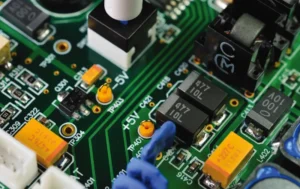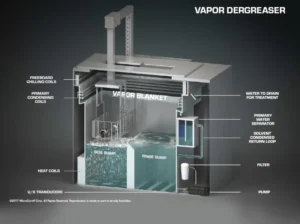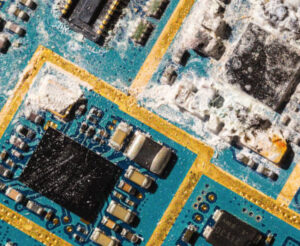Advanced Medical PCB Tech: Precision Cleaning Challenges

The cleaning challenge is to effectively remove contaminants without compromising the integrity of delicate components. (Credit: MicroCare)
As electronic medical device technology progresses, their internal printed circuit boards (PCBs) have undergone a transformative evolution to integrate a diverse array of materials. This evolution is driven by the need to fulfill stringent requirements for enhanced performance, compact size, and heightened reliability. However, the proliferation of materials poses a considerable challenge: finding cleaning solutions capable of efficiently removing contaminants without compromising the integrity of these delicate components.
The Challenge of Contaminant Removal
With the evolution of PCB materials to meet the stringent demands of medical device applications, the challenge lies in effectively removing contaminants without compromising the integrity of delicate components. Contaminants such as flux residues, oils, dust, and solder paste can jeopardize product quality, leading to issues like short circuits, corrosion, and device failure. This not only affects the reliability of medical devices but also risks patient safety, undermines brand reputation, and has the potential for financial losses due to returns, repairs, or recalls.

Vapor degreasing is a reliable method for precision cleaning of complex multi-material PCBs. (Credit: MicroCare)
Complexities of Modern PCBs. Modern medical devices often feature intricate PCB designs with densely packed components and advanced features like bottom termination or tight standoff components. These complexities worsen the cleaning challenge, causing the need for precision cleaning to ensure the best functionality and longevity of medical electronics.
Emerging Materials in Medical PCBs. The medical device industry is seeing the adoption of innovative materials in PCB manufacturing to meet the demands for higher performance and reliability. Although traditional fiberglass-reinforced epoxy laminates continue to hold a significant market share, there has been a discernible rise in the adoption of advanced materials. These include high-frequency laminates and metal-core PCBs which offer unique properties tailored to medical applications, such as enhanced signal transmission, flexibility, and improved thermal management.
Additionally, within the scope of medical device manufacturing, the rise of wearable electronics and flexible displays has instigated advancements in PCBs capable of accommodating bending, twisting, and conforming to diverse shapes while upholding functionality. Materials such as polyimide have been instrumental in helping this evolution by providing flexibility and stretchability beyond the capabilities of traditional rigid PCBs. This not only enhances patient comfort but also underscores the significance of ensuring safety and privacy in medical devices using such flexible PCBs.

Rigorous, early, and frequent testing is crucial to confirm cleaning processes and ensure material compatibility. (Credit: MicroCare)
Eco-Friendlier Materials. Furthermore, there is a growing emphasis on sustainability in medical device manufacturing, driving the adoption of eco-friendly practices such as using bio-based resins, integrating recycled substrates, and using lead-free solder alternatives.
Additionally, nanocomposites have appeared as revolutionary innovations that offer superior mechanical and electrical properties. By incorporating nanoparticles such as carbon nanotubes and nanoceramics into the base material, these nanocomposites offer enhancements in mechanical strength, thermal conductivity, and electrical properties. This technological advancement holds considerable significance in the medical sector, where best performance, compact size, and heightened reliability are pivotal factors influencing product development and patient outcomes.
Challenges in Cleaning Advanced Materials
The proliferation of advanced materials in medical PCBs poses challenges for traditional cleaning methods. Aggressive cleaning agents may damage delicate substrates, while ineffective cleaning can leave behind contaminants that compromise device performance. Therefore, precision cleaning solutions tailored to the specific properties of advanced materials are essential.
Vapor Degreasing as a Reliable Solution. In the medical device manufacturing context, vapor degreasing is a reliable method for precision cleaning of complex multi-material PCBs. This closed-loop system uses low-boiling point, non-flammable cleaning fluids to efficiently remove contaminants without harming sensitive materials. The customizable nature of vapor degreasing allows for the selection of cleaning fluids that match the unique properties of medical PCBs, ensuring thorough cleaning and material compatibility.
Types of Contamination on Medical PCBs. Contaminants can infiltrate PCBs during manufacturing, storage, shipping, and handling, spanning from uncured solder paste to oils, inks, and coatings. To ensure the best performance, thorough cleaning is essential.
Organics: These include rosin solder pastes and fluxes, contributing to robust solder joints. They include solvents, resins, and additives, encompassing polar or non-polar compounds. Specialty cleaning fluids or flux removers effectively combat organic contaminants, with mild to medium strength solutions typically preferred.
Inorganics: Flux and solder paste activators like acids, bases, and halogens are inorganic contamination. Often originating from lead-free or no-clean fluxes and pastes, these residues, particularly white residues, can be challenging to remove. Aggressive cleaning fluids are necessary, but careful assessment is vital to prevent damage to delicate PCB components.
Water: Considered a subset of inorganic contamination, water presents unique challenges for PCB cleaning. Batch drying in a vapor degreaser equipped with a water separator is an effective way to address water contamination. Two drying fluid methods for vapor degreasing are available, contingent on the water quantity:
- Absorption drying is suitable for minimal water quantities. Utilizing a solvent and alcohol mix, this method is hydrophilic, absorbing water from the PCBs to prevent water spots.
- For heavily wet conditions, displacement drying is preferable. This method uses fluids with surfactants to displace water droplets from PCBs. The dense, hydrophobic solvent displaces water, allowing it to rise to the surface of the drying fluid for removal, ensuring comprehensive drying of the PCBs.
Particulate: Commonly present on PCBs, particulate contamination varies in size from submicroscopic to visible debris such as dust, dirt, fibers, and metal chips. Electrostatically adhered to PCB surfaces, particulates need an electrostatic polar cleaning fluid to disrupt the bond and displace them. Added agitation, such as vibrating ultrasonic energy or boiling action, aids in enhancing the cleaning fluid’s effectiveness in removing insoluble contamination.
The Importance of Testing in Medical PCBs

Ineffective cleaning can leave behind contaminants that compromise device performance. (Credit: MicroCare)
Rigorous, early, and frequent testing is crucial to confirm cleaning processes and ensure material compatibility. By conducting thorough testing on sacrificial or test boards, manufacturers can refine their cleaning protocols and select the most suitable cleaning fluids for medical PCBs. Collaboration with critical cleaning experts allows manufacturers to navigate the complexities of PCB cleaning while mitigating risks to material integrity.
A Forward-Thinking Approach
As medical electronics evolve, precision cleaning for multi-material PCBs is crucial in device manufacturing. By embracing forward-thinking strategies like using vapor degreasing and prioritizing solvent material compatibility, medical device manufacturers uphold their highest standards. By integrating thorough testing protocols early in the cleaning process, they can confidently navigate the complexities of PCB cleaning, achieving best product performance and reliability while ensuring patient satisfaction and safety.
Article source: Medical Design Briefs









